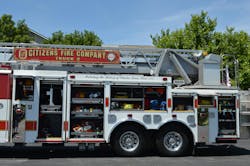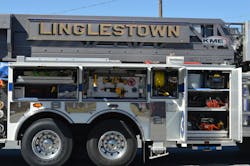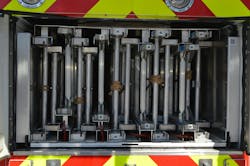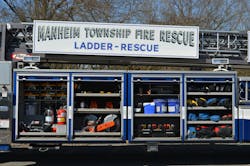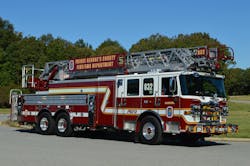The Apparatus Architect: Outfitting Your Truck Company
The extent of technical rescue and other support services that are provided by a department can affect the extent of the tools and equipment that are carried on truck company apparatus. Some departments prefer to operate stand-alone rescue companies, but this largely depends on the available staffing to operate these vehicles along with the engine and truck company units. Rescue and squad companies can provide not only additional staffing but specialized equipment to support routine fireground operations.
Truck companies can be staffed and outfitted to provide these services but also, of course, for safe operation at any incident, including the needed ground ladders. What’s the difference between aerial devices, such as rear-mount aerial ladders, mid-mount tower ladders and truck-drawn aerials, and how they affect operations and the capability to carry the desired tool and equipment cache along with an appropriate complement of ground ladders?
Mission & outside resources
The 2024 edition of NFPA 1900: Standard for Aircraft Rescue and Firefighting Vehicles, Automotive Fire Apparatus, Wildland Fire Apparatus, and Automotive Ambulances no longer stipulates portable equipment and ground ladders within the main body of the document. Table 8.4 provides a list of suggested tools and equipment, including ground ladders. This list is based on the type of apparatus that’s being acquired.
The ladder complement is listed as 115 feet for a truck and 85 feet for a quint, to include two extension ladders and two roof ladders. As a side note, at one point, NFPA 1900 required more than 220 feet of ground ladders, but over the years, the ground ladder complement was lessened. This was in part because of the increased number of quint apparatus that were being produced and put into service.
While not disparaging quint devices, adding a fire pump, water tank and hosebed to any aerial device affects the space that’s available to store ground ladders and the amount of compartment space that can be dedicated to truck company tools. Furthermore, the increased use of battery-powered hand tools, ventilation fans and extrication equipment can affect the space that’s required to mount and store this equipment on any multipurpose vehicle.
Because of staffing and deployment models, some departments must operate with a quint aerial device(s). Therefore, careful consideration must be given to defining the mission of the vehicle and to the appropriate equipment that’s outfitted on the apparatus, particularly when there are limited outside resources to complement the capabilities of a department’s front-line units.
On a quint apparatus, the hosebed area might be located ahead of the aerial turntable or on the side of the body over the lower compartments. How this supply line hose gets loaded and deployed depends on the design of the vehicle. The number and configuration of ground ladders that are desired to be carried on the apparatus is determined by the available space that’s under the turntable and outside of the body based on water tank size, depth of the body compartments, amount of supply line that’s carried and the location of other components, such as hydraulic oil reservoir and generator, along with water way piping for the device. A trade-off might be to carry additional ground ladders in a side-stack arrangement, where the ladders can be deployed easily by a single person.
Needs assessment
Members of an apparatus committee should conduct an assessment of the structural conditions in the response district to review buildings where access to current or planned new aerial apparatus would be limited. They then should seek out the number and appropriate working length of ground ladders that are required to protect not only potentially trapped occupants but department personnel, too.
With this in mind, few communities have any type of structural conditions by which a ladder company that has just two extension ladders could position ground ladders safely on multiple sides of the building. A review of past incidents can determine the frequency of use of the different lengths of ground ladders and can assist the apparatus committee in determining the appropriate ladder configuration that’s needed for a new vehicle.
Likewise, a community-based aerial needs-assessment might make sense as a means of determining the appropriate type of aerial device for the district. An evaluation of building heights, setbacks, parking areas and green spaces provides data to determine the suitable working height and vertical reach that’s required to access these areas.
Several apparatus manufacturers produce single-axle rear-mount aerial ladders in varying working heights, which provides a short-wheelbase-and-overall-length vehicle to operate in tight, urban areas. Quint apparatus that are built on a single axle are limited with respect to the compartment size and space that’s available for ground ladders, particularly where all ground ladders are deployed only from the rear body of the vehicle.
Midship tower ladder
Midship-mounted tower ladders first were developed for departments that had apparatus bay doors that were shorter than 11 feet. For the most part, the rigs were built without a fire pump or a water tank, to maximize the equipment and ground ladder complement.
Current midship tower ladders can provide a number of body compartment layouts. However, higher body designs can limit tower operations at lower angles. Electric cable reels, scene lighting, saw boxes and other equipment should be located on the body of the rig, so they don’t inhibit low-angle operations nor limit the scrub area of the device.
Detailed list
In addition to determining the type of aerial device that would work in a response district, members of the apparatus committee must determine the inventory of tools and equipment that must be carried on the apparatus. NFPA 1900 provides some guidance for a starting point of 2,500 lbs. of equipment. This is the minimum weight allowance that each apparatus manufacturer must provide, regardless of the make and model of the aerial device. Mid-mount tower ladders typically have counterbalance weight added to them to provide sufficient stability during operations along with offloading weight on the front axle on some units.
Determining an accurate accounting of tools and equipment is critical in the design phase. This isn’t only to avoid an overweight condition but also to keep the vehicle in balance from front to rear and side to side when the vehicle is fully outfitted. Ensure that your department provides a detailed listing of the anticipated hose, tools and equipment that are planned to be carried on the vehicle to the apparatus sales representative. Then have the manufacturer’s engineering group provide a detailed weight analysis for review and approval by all parties prior to contract, to confirm that the apparatus design will meet the department’s needs.
Tractor-drawn ladders have a distinct advantage of having almost unlimited space to carry portable ladders both inside of the trailer and on the body compartments. Where there is a requirement to carry a number of longer roof and wall ladders in addition to multiple two-section extension ladders, a tractor-drawn aerial can accommodate more than 300 feet of portable ladders easily, with room to spare. Tractor-drawn ladders can provide extensive compartment space to carry equipment, including hydraulic rescue tools, air bags, stabilization jacks and other equipment that’s required for technical rescue.
Current and future needs
Consider the concepts that are noted above during the initial design process of ladder company apparatus. Defining the mission of the vehicle and melding this with the operational needs of the department while staying within the organization’s fleet replacement plan go a long way toward ensuring a safe and well-designed aerial apparatus.
The old adage states, “What is old is new again.” When working with your apparatus committee, take time to study your department’s history and determine the current and future needs of the response district. The apparatus that you design today must provide service to the community for the next 15–20 years and embrace available technologies while enhancing the safety for members. Given the current apparatus market conditions, in which an aerial ladder and tower ladder can cost in excess of $2 million and require a 3–4-year production time, upfront planning pays dividends when the new vehicle is placed into service. Your fire department and the community deserve nothing less.
About the Author

Tom Shand
TOM SHAND, who is a Firehouse contributing editor, is a 36-year veteran of the fire service. He works with Michael Wilbur at Emergency Vehicle Response, consulting on a variety of fire apparatus and fire department master-planning issues. Shand is a member of the Firehouse Hall of Fame.
Michael Wilbur
MICHAEL WILBUR, who is a Firehouse contributing editor, retired as a lieutenant in FDNY, where he was last assigned to Ladder Company 27 in the Bronx. He has served on FDNY's Apparatus Purchasing Committee and consults on a variety of apparatus-related issues around the country. Wilbur is a member of the Firehouse Hall of Fame. For further information, access his website at www.emergencyvehicleresponse.com.
